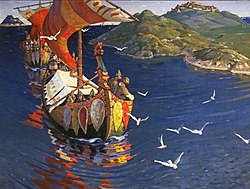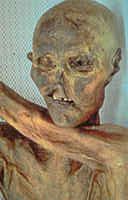I feel like we are jumping back and forth in some
subjects.. like the theorys of revolution.. so how do we really know??
In case with your dilemmas...
The Venetians - our early Ancestorsby Ivan Kobal
Source link: carantha.net/forum_veneti_part_i.htm
History, unlike mathematics, is an imperfect science and can never be complete or totally impartial.
Facts are denied, distorted, ignored, forgotten. History is often written long after the denials, the distortions, the memories of events and their consequences have disappeared. When the bare facts of the past resurface like fossilized plants or prehistoric animals, the expert historian is there to draw conclusions.
Such conclusions are often incompatible with accepted traditions and beliefs, and it takes all the skill of the historian to convince the conservative scholars that their beliefs are being proved wrong.
One more important fragment ...
The German version of the book, "Unsere Vorfahren die Veneter", caused a stir among German historians and history teachers, so did in Italy and elsewhere the Italian edition, "I VENETI, progenitori dell'uomo Europeo". In Slovenia, the book was not welcome at first and the old school of scholars, who for centuries maintained that all the Southern Slavs, including the Slovenians, migrated in mass from the region of the Carpathian Mountains in the 6th century AD, tried to ignore it. But the bug didn't go away and the controversy is now raging unabated.
I would now elaborate my position on situation in case with examination of Slavic past. To underline- same conclusions goes also for particular situation in case with examination/re-examination of Polish ancient history ...
If we want to understand some historical processes, we should examine as much as possible new scientific sources and materials based on transhistorical orientation and multidisciplinary approach which accepts results that are so far realized and which ignore dogmatic and daily-political limits, and taking into consideration all new efforts based on strictly scientific laws with the goal of shedding new light on old Slavic civilization and true meaning of her contribution to development of universal civilization.
Affirmation of newest research results is inevitable, because new scientific approach includes consultations with multidisciplinary experts (archeology, linguistics, mathematics, anthropology, ethnology, history- from aspect of many scientific branches, geography, arts, physics, genetics, climatology ...).
Theories that have so far been put forward, including all the consequences they brought, didn't gave correct answer on crucial questions from Slavic - Proto Slavic - Indo European past.
We need to penetrate into new sources and reveal the true ones- scientifically established but rejected hidden truths that could give a batter image on the development and evolution of Paleo/Proto Slavic civilization.
INTERPRETATION OF THE ANCIENT CULTURES
by Sergei V. Rjabchikov
after reading Rjabchikov, I would also suggest you to see works of some Slovenian authors (on the same link from above)
The VenetiWenden, Winden, Windische
by Dr. Jožko Šavli
A mysterious people, whose traces we encounter in the nomenclature and in the customs throughout Germany as well as in nearby countries. Their name reflects also the form of the present-day linguistic groups like Wenden (Sorben of Lusatia), Winden (Kashubi of Pomerania) or Windische (Slovenians) and also Veneti (in Veneto, Italy). Their traces are to be found in all territories between the Baltic and the Adriatic Sea, where today different nations live. Who were the Veneti?
many inscriptions in Venetian writing appeared around 500 BC. Numerous examples of these inscriptions are conserved until today, and it is a very important fact, that the Slovene linguist Matej Bor was able to decipher many of them on the basis of the Slovenian and other Slav languages.
O S T I J A R E JO
S T I J A K O U S E D I C AB U G O Š A S O V I Š A DL Y K Z (e) M E L I N K(o) S H A J I C O S K A B (i)Then, on the same link, real gift for all those who seek to explore thru time (open-mindedly) ...
Found: Europe's oldest civilisation11 June 2005
By courtesy of our reader, who forwarded the article to Carantha
Our question is: Did it pertain to the Vends?
Archaeologists have discovered Europe's oldest civilisation, a network of dozens of temples, 2,000 years older than Stonehenge and the Pyramids. More than 150 gigantic monuments have been located beneath the fields and cities of modern-day Germany, Austria and Slovakia. They were built 7,000 years ago, between 4800 BC and 4600 BC. Their discovery, revealed today by The Independent, will revolutionise the study of prehistoric Europe, where an appetite for monumental architecture was thought to have developed later than in Mesopotamia and Egypt.
A settlement of the Band Ceramic people. In the background we see part of a typical longhouse. (The illustration has been taken from the book: Frühe Geschichte der Lausitz by Lech Leciejewicz, 1985).The SlovieniA Venetic Stock in Russia
by Dr. Jožko Šavli
They were the founders of the Slovenia there, which later was called »The Republic of Novgorod« The discovery of common roots represents a new base of friendship between Russians and SloveniansThe well-known Russian chronicler Nestor mentions the appearance of the Slovieni race among the first Russian tribes in his "Povest' vremennych let" (11th/12th century AD). According to Nestor, they settled around the Ilmen Lake south of Sankt Petersburg, and founded the city of Novgorod. - It is certain, that the Slovieni of this area came from elsewhere. But Nestor does not state, where did they migrate from and when did this happen. Therefore, several scholars researched their primordial homeland, and they are still doing so.
The early settlement area of the Slovieni (Russia)The Slovieni (Russia)
Tacitus, it is true, indirectly quotes the settlement of a group of Veneti in the then Finnic territory. That this group was called Veneti in the West is evidenced by the following facts: Still in the 16th century, on a carta marina, elaborated by Olaus Magnus, the Finnic Gulf is denoted as: Mare Finonicvm sive Sinvs Venedicvs. The Sinvs Venedicvs (Venetic Gulf) could only have been named after the Slovieni (Novgorod), at that time already subjected to the supremacy of Moscow.
Slovensk (Novgovord) in the 1st century AD (reconstruction).
The settlement was composed of wooden houses.View on medieval Novgorod and the city plan, indicating the Slovenski konec with the Slovenski holm (Slovenian hill)On the same link, you would found interesting approach in case with some historical controversies, which by some authors could be in connection with ancient Slavic past, with that indirectly, with Polish too.
Alexander the Great356 - 323 BC
Was he a Venet?
The Macedonian questionby Dr. Jožko Šavli
Alexander the Great (356 - 323 BC)Fragmets:
The discovery of the Veneti re-opened anew the question of the language spoken by the ancient Macedonians. In this connection, Charles Bryant-Abraham recorded Alexander the Great (356 - 323 BC), King of Macedonia and Greece, who, at a gathering admonished one of his men, Philotas by name, to talk in his mother tongue and not in Greek (cf. The Augustan, Vol. XXXI, Nr. 3, Daggett, Calif. 1999, p. 21). His mother tongue could have been only Macedonian, which evidently was different from Greek.
Yet, to which linguistic group pertained the then Macedonian language? I would say, we find a reliable answer in the inscriptions of Dura-Europos, deciphered by Anthony Ambrozic (cf. his book on "Adieu to Brittany", Toronto 1999, p. 74 ff.). He deciphered inscriptions based on the language, which I call Venetic, from which the Slav languages descended.
In my researches concerning the Veneti, I found out, that in the pre-Roman period several peoples spoke nearly the same language: Illyrians, Thracians, Dacians, continental Celts, very probably also Phrygians,... But they were not of Venetic origin. Anyway, with regard to the Macedonians, an important indication of their Venetic origin is the quotation of Herodotos (ca. 480 - 425 BC), who also mentioned the presence of the Veneti in the Illyricum (I, 196), i.e., in the Balkans. But where was the territory of their settlement?
Pella, north of Salonika, was the capital of Alexander the Great and of Macedonia. In the South it bordered on Thessaly, where still today the names Venetikos and Veneton bear witness of the Venetic origin of the Macedonian peopleDionysus riding the Panther (Pella, mosaic of ca. 300 BC). The panther (leopard) was a divine animal in the suite of several divinities already in the antiquity PolishForums LIVE / Archives [3]
PolishForums LIVE / Archives [3]









.jpg/250px-Jogaila_(W%C5%82adys%C5%82aw_II).jpg)


